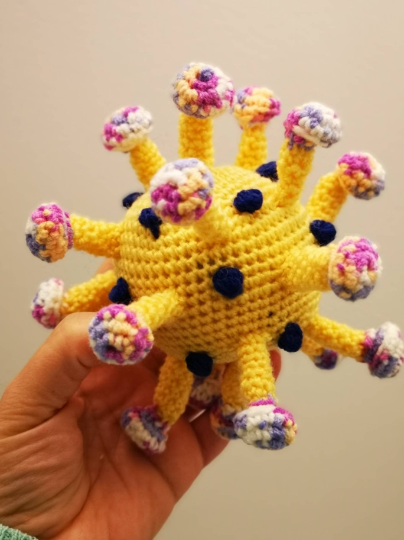5 May 2021
DrawnToGeoscience: #CrochetYourPHD
Posted by Shane Hanlon

Coronavirus model. Credit: Tahani Baakdhah
By Tahani Baakdhah
From neurons under the microscope to crocheted neurons a story worth sharing. The art of science and the science of the art never been a part in my sciart journey. Art was always a way of life. During elementary and high school days, I was a member of the art club and regularly participated in painting, drawing, sewing, and textile art classes. I developed many skills back then that helped me in building my art career.I was also taking a science major in high school and continued attending medical school right after.
Studying both science and medicine inspired me to use my passion for art in medical and scientific illustrations. Using illustrations, all complex science ideas become easy to understand. So I tried to be creative in illustration using crocheted 3D models. My imagination was the fuel to my creativity. I used yarn as my paint and the hook as my brush. I started crocheting retinal stem cells and retinal neurons, as this is my field of study, in a project called “#crochetyourphd”. I shared all the patterns at my Etsy shop and in my book Crocheting Neuroscience: The Retina. I then branched out, crocheting many science and medical models outside my field with the aim of communicating science with the public and science lovers everywhere.
I want to make science accessible to everyone. During the current pandemic, I designed a SARS-Cov-2 crochet model. I used this model in a series of social media posts to educate my followers about the new virus. This model has been featured on many news and websites. I also shared the pattern on my Etsy shop and Youtube channel so other people can create this virus on their own. Before the pandemic, I used my models in science communication and outreach events including: schools, public libraries, public places and Universities. My work was exhibited at UofT (Koffler student centre) as part of a “Narrating Neuroscience” event. I also had the opportunity to participate in a Sciart panel organized by SciArt Salon, which took place at the Field Institute in 2017.
It is always great to remember that science communication is a deep sea of learning, the more you dive in, the more secrets you will learn and the more treasures you will find. Bringing these treasures to the surface does not always require complex tools or extraordinary skills. You will be surprised if I told you that simple methods will work the best. From storytelling to science writing, the terms and the language you use really make a difference. For me this language was based on art. Art is the only language that needs no translation and if you were creative your art can easily cross all borders. Always look for things that fuel your creativity and inspire others.
-Tahani Baakdhah is a Postdoctoral Researcher at University Health Network


 The Plainspoken Scientist is the science communication blog of AGU’s Sharing Science program. With this blog, we wish to showcase creative and effective science communication via multiple mediums and modes.
The Plainspoken Scientist is the science communication blog of AGU’s Sharing Science program. With this blog, we wish to showcase creative and effective science communication via multiple mediums and modes.